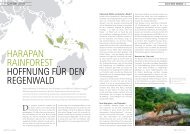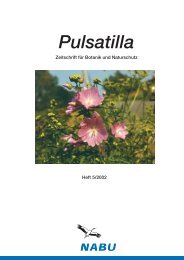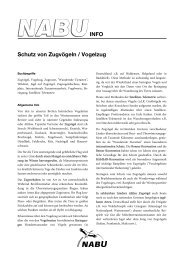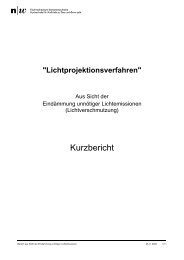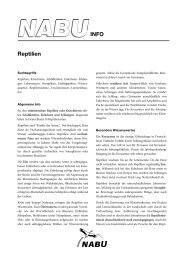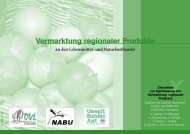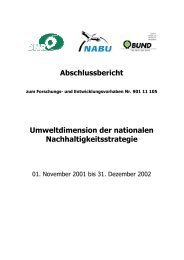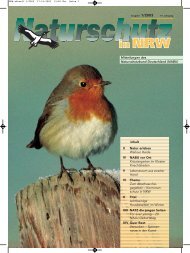Studie "The GMO-emperor has no clothes" (engl.) - Nabu
Studie "The GMO-emperor has no clothes" (engl.) - Nabu
Studie "The GMO-emperor has no clothes" (engl.) - Nabu
Create successful ePaper yourself
Turn your PDF publications into a flip-book with our unique Google optimized e-Paper software.
co-exist with the independence and freedom of<br />
science.<br />
A Canadian study showed that traces of the<br />
Bt toxin from Monsanto Bt corn were found<br />
in the blood of 93 percent of women and 80<br />
percent of their umbilical cord and fetal blood<br />
(Aris A, Leblanc S, “Maternal and fetal exposure<br />
to pesticides associated to genetically modified<br />
foods in Eastern Township of Quebec, Canada”,<br />
Reproductive Toxicology, May 31, 2011 (4) 526-<br />
33, Epub 2011 Feb/8).<br />
Monsanto’s false argument for safety was that the<br />
Bt toxin in Bt crops poses <strong>no</strong> danger to human<br />
health because the protein breaks down in the<br />
human gut. However, the study shows that the Bt<br />
toxin survives in the blood of pregnant women<br />
and is also detected in fetal blood.<br />
Evidence of liver and kidney toxicity appeared<br />
when rats were fed an approved GE maize variety<br />
(Mon 863) (Seralini GE, Cellier D. & Spironx<br />
de Vendomois, J, 2007, “New analysis of rat<br />
feeding study with a GM Maize”, Archives of<br />
Environmental Contamination and Toxicology,<br />
10,1007, S 00244-006-0149-5). Similar effects<br />
were observed when Monsanto fed its GT-73<br />
Roundup Ready ca<strong>no</strong>la variety to rats. <strong>The</strong> rats<br />
showed a 12 percent to 16 percent increase in<br />
liver weight. (Greenpeace (2004) “Greenpeace<br />
critique of Monsanto’s Roundup Ready Oilseed<br />
rape, GT-73”, http://www.greenpeace.at/uploads/<br />
media/GT73_Greenpeace_comments_Oct_2004_01.<br />
pdf ).<br />
In 2005 CSIRO abandoned a decade long project<br />
to develop GE peas after tests showed they caused<br />
allergic lung damage in mice. (Young E. (2005)<br />
GM Pea causes allergic damage in Mice, New<br />
Scientist, http://www.newscientist.com/article/dn8347-<br />
gm-pea-causes-allergic-damage-in-mice.html).<br />
A survey was conducted by Navdanya under Bt<br />
cotton growing areas of Vidharbha. Twenty-five<br />
fields were selected where Bt cotton was grown<br />
for three years, which was compared with the<br />
adjoining fields where either other varieties of<br />
cotton were growing or other crops were growing<br />
during that period. <strong>The</strong> areas covered between<br />
Nagpur, Amravati, Wardha and adjoining areas.<br />
<strong>The</strong> result showed significant reduction in acid<br />
phosphatase (26.6 percent), nitrogenase (22.6<br />
percent) and dehydrogenase (10.3 percent)<br />
activities under Bt cotton growing fields. A slight<br />
reduction in esterase (7.6 percent) and alkaline<br />
phosphatase (0.7 percent) activity was observed<br />
but the results are <strong>no</strong>t statistically significant.<br />
<strong>The</strong> results clearly demonstrated that Bt cotton<br />
cultivation definitely affect soil biological<br />
health especially beneficial microorganisms<br />
(acti<strong>no</strong>mycetes, bacteria) and enzymes (acid<br />
phosphatase, nitrogenase and dehydrogenase).<br />
(Effect on Soil Biological Activities due to<br />
Cultivation of Bt cotton, Navdanya, 2008).<br />
Other statements and scientific studies done<br />
on the risks posed to human health by Bt:<br />
In general, main health concerns are toxicity<br />
and allergenicity.<br />
Even the World Health Organization (WHO)<br />
cautions that “Different GM organisms include<br />
different genes inserted in different ways. This<br />
means that individual GM foods and their<br />
safety should be assessed on a case-by-case<br />
basis and that it is <strong>no</strong>t possible to make general<br />
statements on the safety of all GM foods.”(“20<br />
Questions on Genetically Modified Foods.”<br />
World Health Organization. http://www.who.int/<br />
foodsafety/publications/biotech/20questions/en/).<br />
Many studies have shown that Bt poses<br />
potential risks to insects and animals, but<br />
there <strong>has</strong> been little study of its potential<br />
impact on human health. (“Why GM Crops<br />
are Dangerous” People and Planet, February 5<br />
2009. http://www.peopleandplanet.net/?lid=29012<br />
§ion=34&topic=27).<br />
1999 Nature study showed adverse effects of<br />
transgenic pollen (from Bt corn) on monarch<br />
butterflies: butterflies reared on milkweed<br />
leaves dusted with bt corn pollen ate less, grew<br />
more slowly, and suffered higher mortality.<br />
(J. Losey, LS. Rayor, M.E. Carter. “Transgenic<br />
pollen harms monarch larvae” Nature vol 399.<br />
May 20 1999).<br />
Evidence of organ damage: A 1999 study<br />
showed that rats fed GE potatoes experience<br />
adverse effects on their intestinal tracts. (SWB<br />
Ewen, A. Puzstai. “Effect of diets containing<br />
genetically modified potatoes expressing<br />
Galanthus nivalis lectin on rat small intestine.”<br />
<strong>The</strong> Lancet, Vol 354 issue 9187, pages 1353-<br />
1354, 16 October 1999.). In addition, rats<br />
fed GE tomatoes developed stomach lesions,<br />
and rats fed a different kind of GM potatoes<br />
had smaller and atrophied livers. Rats fed Bt<br />
corn had liver lesions, and rabbits fed GE soy<br />
showed altered enzyme production in their<br />
livers as well as higher metabolic activity.<br />
Rats fed Roundup Ready soybeans also<br />
showed structural changes in their livers. (C<br />
Verma, S Nanda, RK Singh, RB Singh, and S<br />
Mishra. “A Review on Impacts of Genetically<br />
Modified Food on Human Health.” <strong>The</strong> Open<br />
18



